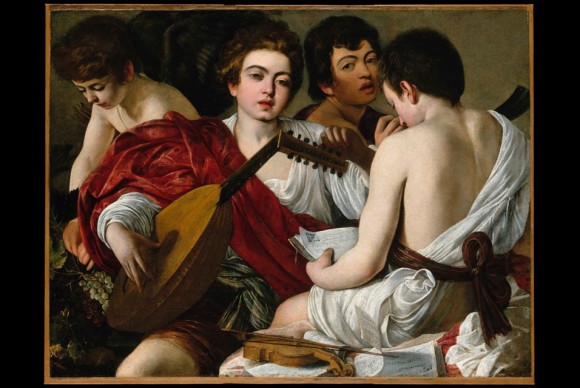National Gallery of Canada Unveils Rare Exhibition Caravaggio and His Followers in Rome
OTTAWA.- On June 17, the National Gallery of Canada unveils its much anticipated, ground-breaking exhibition, Caravaggio and His Followers in Rome. The exhibition brings the genius of Caravaggio to Canada for the first time ever and is presented exclusively in Canada at the NGC. On view until September 11, 2011, this prestigious, international exhibition features 58 works by more than 30 artists, 12 of which are by Caravaggio. Among them is the recently discovered St. Augustine, a painting lost since the 19th century which will be publicly exhibited for the first time. The exhibition is presented by the Canadian Association of Petroleum Producers.
“Caravaggio’s influence on artists throughout Europe was profound. Not only will this exhibition give viewers an opportunity to see some of the finest paintings of the 17th Century, they will also see artists emulate their heroes while distinguishing themselves, a dynamic that keeps art moving forward to this very day,” said
NGC Director Marc Mayer.

Michelangelo Merisi da Caravaggio, The Musicians, c. 1595, oil on canvas, 92.1 x 118.4 cm. The Metropolitan Museum of Art, New York. Rogers Fund, 1952 (52.81) © The Metropolitan Museum of Art / Art Resource, New York.
An exhibition that brings new scholarship to light
New archival research on the Caravaggisti in Rome reveals changes in both the ‘geography’ and chronology of the Caravaggesque movement. In addition, the structure of the exhibition emphasizes Caravaggio’s impact on different genres of painting, from musical scenes, fortunetellers and cardsharps to individual saints and religious narratives. At the same time, the carefully selected works of the best Caravaggesque painters helps to determine how Caravaggio’s most important contemporaries perceived his works and which of his pictorial innovations had the most dramatic impact.
The structure of the exhibition also emphasizes Caravaggio’s impact on different genres of painting, from musical scenes, fortunetellers and cardsharps to individual saints and religious narratives. At the same time, the carefully selected works of the best Caravaggesque painters helps to determine how Caravaggio’s most important contemporaries perceived his works and which of his pictorial innovations had the most dramatic impact.
Caravaggio and His Followers in Rome is co-organized by the NGC and the Kimbell Art Museum in Fort Worth, Texas and curated by Dr. David Franklin, former NGC Deputy Director and Chief Curator and is now Director of the Cleveland Museum of Art, and Dr. Sebastian Schütze, Professor and Chair of the Department of Art History at the University of Vienna.
The exhibition charts Caravaggio’s development over the course of the infamous period he spent in Rome and chronicles his profound impact on artists in Italy and Europe including Valentin de Boulogne, Gerrit van Honthorst, Simon Vouet, Peter Paul Rubens, Orazio Gentileschi and his daughter Artemesia, and Georges de la Tour. Within the exhibition’s thematic display, Caravaggio’s compelling images are juxtaposed with those he inspired.
International loans are a vital component of this exhibition. A total of 47 have been secured from public institutions and private collections from 13 countries throughout Europe and North America, including the Musée du Louvre, Galleria degli Uffizi, Musei Vaticani, Museo Nacional del Prado, The National Gallery (London, UK), The Metropolitan Museum of Art and the Kimbell Art Museum. Five paintings are drawn from the NGC’s own European collections.
NGC’s European Collections Highlighted
The NGC possesses a particularly fine collection of European paintings including a number of works by Caravegequee painters. This exhibition underscores the depth of collection as well as highlighting new purchases such as the Pensionante di Saraceni and the Paulus Bor.
Caravaggio’s new kind of art
Electrifyingly original, dynamic, and evocative, Michelangelo Merisi da Caravaggio was an artist whose life was rife with conflict and whose creations veered perilously between the sacred and the profane. One of the most innovative artists in the history of Western art, he introduced new techniques, including the use of light and dark (chiaroscuro) to heighten dramatic effect; he played with perspective and concepts of time and space and introduced a brand of stark realism that shocked many of his patrons. Rejecting previous artistic practices, he painted directly onto the canvas (rather than starting with a sketch); and used from live models (often from the outer margins of society) who posed in his studio. Through his scenes from the demi-monde, mythology and religion, he created a new kind of art that was a total departure from the Mannerism style of the Renaissance period, and which was accessible but dramatic, deeply emotional and profoundly human. Thus he broke the boundaries between art and life, overturned artistic conventions of the day, gave birth to the Baroque era and to modern painting.
What critics said about Caravaggio
“In the aftermath of the Renaissance, what begins in the work of Caravaggio is quite simply the start of modern painting.” André Berne-Joffroy
Related posts:
- National Gallery of Canada Acquires Nine Exceptionally Rare Prints by Rembrandt, Durer and Whistler
- Painting at Center of Caravaggio Mystery Unveiled in Rome
- Gemäldegalerie Celebrates 400th Anniversary of Caravaggio’s Death with Exhibition
- The Last Work by the Renowned Italian Master Caravaggio at Rembrandt House Museum
- National Gallery of Canada Realigns Its Organization
